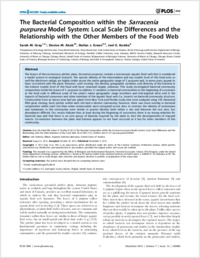The bacterial composition within the Sarracenia purpurea model system: local scale differences and the relationship with the other members of the food web
- Gray, Sarah M. Department of Ecology and Evolution, Stony Brook University, Stony Brook, New York, USA - Unit of Ecology and Evolution, Department of Biology, University of Fribourg, Switzerland
- Akob, Denise M. Institute of Ecology, Friedrich Schiller University, Jena, Germany
- Green, Stefan J. DNA Services Facility, Research Resources Center, University of Illinois at Chicago, USA, - Department of Biological Sciences, University of Illinois at Chicago, USA
- Kostka, Joel E. Georgia Institute of Technology, Schools of Biology and Earth & Atmospheric Sciences, Atlanta, USA
-
05.12.2012
Published in:
- PLoS ONE. - 2012, no. 12, p. e50969
English
The leaves of the carnivorous pitcher plant, Sarracenia purpurea, contain a microscopic aquatic food web that is considered a model system in ecological research. The species identity of the intermediate and top trophic level of this food web, as well the detritivore midge, are highly similar across the native geographic range of S. purpurea and, in some cases, appear to have co-evolved with the plant. However, until recently, the identity, geographic variation, and diversity of the bacteria in the bottom trophic level of this food web have remained largely unknown. This study investigated bacterial community composition inside the leaves of S. purpurea to address: 1) variation in bacterial communities at the beginning of succession at the local scale in different areas of the plant’s native geographic range (southern and mid-regional sites) and 2) the impacts of bacterial consumers and other members of the aquatic food web (i.e., insects) on bacterial community structure. Communities from six leaves (one leaf per plant) from New York and Florida study sites were analyzed using 16S ribosomal RNA gene cloning. Each pitcher within each site had a distinct community; however, there was more overlap in bacterial composition within each site than when communities were compared across sites. In contrast, the identity of protozoans and metazoans in this community were similar in species identity both within a site and between the two sites, but abundances differed. Our results indicate that, at least during the beginning of succession, there is no strong selection for bacterial taxa and that there is no core group of bacteria required by the plant to start the decomposition of trapped insects. Co-evolution between the plant and bacteria appears to not have occurred as it has for other members of this community.
- Faculty
- Faculté des sciences et de médecine
- Department
- Département de Biologie
- Language
-
- English
- Classification
- Biological sciences
- License
-
License undefined
- Identifiers
-
- RERO DOC 30920
- DOI 10.1371/journal.pone.0050969
- Persistent URL
- https://folia.unifr.ch/unifr/documents/302863
Statistics
Document views: 100
File downloads:
- pdf: 158
